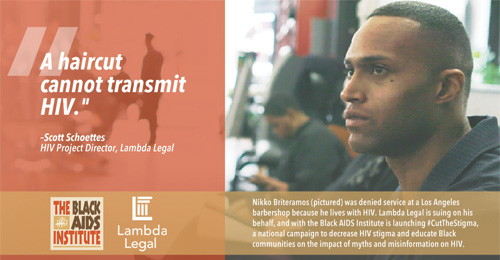Another “finally” moment in HIV drug development came in July: the FDA approved the first single-tablet regimen (STR) containing a protease inhibitor.
The HIV protease inhibitor class of drugs created the Lazarus effect in the epidemic, in the late 1990s. Back then, they were difficult to take. Over the years, many protease inhibitors (PIs) dropped off in use. Some are no longer even available.
Darunavir, first approved in 2006 as a new-and-improved PI, has survived. It’s not only powerful, but—for the most part—tolerable. It’s for these two reasons that darunavir has become the top gun of the protease inhibitors.

The new Symtuza contains darunavir boosted with a small dose of the blood level enhancer cobicistat. It also contains the two medications found in Descovy, emtricitabine and tenofovir alafenamide. The dose is one film-coated tablet once daily with food.
“Many people living with HIV struggle to adhere to their medication, which can lead to the development of drug resistance and potentially cause their medication—or even an entire class of medications—to stop working,” said Joseph Eron, M.D., Professor of Medicine and Director, Clinical Core, University of North Carolina Center for AIDS Research, Chapel Hill, N.C., in a press release from Janssen Pharmaceutical Companies.
In fact, the FDA allowed Janssen to advertise Symtuza as “help[s] protect against resistance.”
“In key Phase 3 clinical trials, Symtuza successfully treated those who were starting therapy,” said Dr. Eron, “as well as those who were stably suppressed on antiretroviral (ARV) therapy—including patients with more complex treatment histories or previous virologic failure—demonstrating its potential as an important new treatment option for a wide variety of patients.”
At this moment in time, U.S. HIV treatment guidelines recommend the newer integrase inhibitor (INSTI) drugs for first-time therapy in “most people with HIV.”
Only two PIs are recommended for initial therapy, and then “in certain clinical situations.” Of the two, darunavir is preferred over atazanavir.
The treatment guidelines from Health and Human Services list reasons why the INSTIs are preferred for most individuals. Then it states that, “An exception is in those individuals with uncertain adherence or in whom treatment needs to begin before resistance testing results are available (e.g., during acute HIV infection, pregnancy, and in the setting of certain opportunistic infections). In this context, DRV/r [darunavir boosted by ritonavir] may have an important role given the low rate of transmitted PI resistance, its high genetic barrier to resistance, and low rate of treatment-emergent resistance during many years of clinical experience.” HHS uses bioequivalence data comparing cobicistat-boosted darunavir to ritonavir-based darunavir to recommend cobicistat-boosted darunavir for initial use. DRV/r does not have this recommendation.
Of note, the guidelines immediately pointed out that dolutegravir, an INSTI, may also be considered for use before resistance testing results are available. Symtuza may also be used in this scenario, as long as people taking it have had undetectable viral load for at least six months before going on it. Moreover, unlike the other HIV drugs, people with previous treatment failure were allowed to enter into Symtuza clinical studies. Approximately 15% of participants had previous HIV treatment failure.
The guidelines also point out that “an observational cohort study suggested that DRV/ritonavir is associated with increased rates of cardiovascular disease; data on DRV/cobicistat are too limited to draw conclusions.”
Darunavir contains a sulfa component, so it should be used with caution by people with sulfa allergies. Diarrhea, rash, and nausea were reported in clinical research. Severe rash with darunavir is rare but potentially life-threatening. Check for hepatitis B before taking Symtuza.
Another side effect is the price: around $40,000 a year, the highest ever for an HIV pill. There is a free 30-day start program for new Symtuza users and the co-pay assistance program has gone up to $10,500.
Darunavir is available under the brand name Prezista, and is also found in the co-formulated pill Prezcobix (with cobicistat). Compared with tenofovir DF, found in Truvada, the tenofovir alafenamide (TAF) in Symtuza is safer on kidney and bone health. Also as a result of the TAF, Symtuza can be taken by people with more advanced kidney disease, down to a renal function (CrCL) of 30. Go to positivelyaware.com/symtuza.
Lambda Legal, the national rights organization for the LGBTQ community, and Los Angeles-based Black AIDS Institute (BAI) have teamed up for an education campaign called Cut the Stigma, focusing on black communities to “dispel misconceptions surrounding the transmission of HIV and reduce HIV stigma and its resulting discrimination.” The campaign was developed after the owner of an L.A. barbershop refused to cut the hair of a customer living with HIV.
“My experience at the Leimert Park barbershop was not the first I have had with HIV discrimination. Today, I am speaking out because I would like it to be my last,” said Nikko Briteramos, 34, who has been living with HIV since he was 19, in a press release. “I want everyone to hear my story so they can better understand how harmful these moments of discrimination can be to those living daily with HIV. The stigma is a result of misconceptions and it needs to end.”
Scott Schoettes, Counsel and HIV Project Director at Lambda Legal, said, “The facts of this case, as well as the legal claims, are pretty straightforward: the owner of King of Kuts in Leimert Park refused to cut Nikko’s hair because he is living with HIV, in clear violation of the federal Americans with Disabilities Act (ADA) as well as the California Unruh Civil Rights Act. While we work within the legal system to remedy the dignitary harms Nikko suffered as a result of this discriminatory encounter, we are also partnering with Black AIDS Institute to engage with Black communities nationally to do some critically important public education to prevent such discrimination from happening in the first place.”
“It was important for BAI to get involved in Nikko’s case because there’s no way to end the AIDS epidemic if we’re not fighting bigotry, discrimination, and bias,” said Phill Wilson, CEO and founder of the Black AIDS Institute. “In addition, as a Black organization, we have to be ever vigilant in confronting injustice. It is a part of our survival. We fight those injustices to survive—and this is a case about injustice. It’s about bias. It’s about bigotry. It’s about discrimination. We have an obligation to be at the forefront of that effort; that’s essential.”
Wilson continued, “We are well aware that HIV discrimination does not only occur in the Black community. But Nikko’s experience highlights how Black people living with HIV are often confronted with discrimination connected to stigma and misinformation in public places of importance within our community. The barbershop is a sacred social space, where Black Americans debate social, cultural, and political ideas. HIV discrimination destroys such safe spaces. Through this partnership with Lambda Legal on Cut the Stigma, Black AIDS Institute intends to engage barbers across the country in an effort to end the harmful effects of HIV discrimination that stems from misinformation.”
To Learn more about the case, go to lambdalegal.org/nikko. For more about the Cut the Stigma campaign go to blackaids.org/CutTheStigma.
The HIV medication Intelence (etravirine) has been approved by the FDA for use by children ages 2 to 5 who weigh at least 22 pounds (10 kg). The dose is 100 mg twice daily (the adult dose is 200 mg twice daily). The FDA reiterated instructions for those unable to swallow the tablets whole with water. Follow instructions on the label. Intelence is a non-nucleoside reverse transcript inhibitor (NNRTI). The approval came in July. Go to positivelyaware.com/intelence.
ViiV Healthcare reported finding similar efficacy for a once-a-month injection of two HIV medications at one year compared with a regular oral triple-drug antiviral regimen. The injectable combination used ViiV’s cabotegravir, which is still in development, along with Janssen Therapeutics’ rilpivirine. The global ATLAS Phase 3 study included 618 men and women from around the world.
The FDA in June approved two generic versions of the opioid dependence medication Suboxone.
“The FDA is taking new steps to advance the development of improved treatments for opioid use disorder, and to make sure these medicines are accessible to the patients who need them. That includes promoting the development of better drugs, and also facilitating market entry of generic versions of approved drugs to help ensure broader access,” said FDA Commissioner Scott Gottlieb, M.D., in a press release. “The FDA is also taking new steps to address the unfortunate stigma that’s sometimes associated with the use of opioid replacement therapy as a means to successfully treat addiction. Patients addicted to opioids who are eventually treated for that addiction, and successfully transition onto medicines like buprenorphine, aren’t swapping one addiction for another, as is sometimes unfortunately said. They’re able to regain control of their lives and end all of the destructive outcomes that come with being addicted to opioids. When coupled with other social, medical, and psychological services, medication-assisted treatments are often the most effective approach for opioid dependence.”
The FDA in June issued a draft guidance on the development of products for PrEP (pre-exposure prophylaxis). “Specifically,” the agency announced, “this guidance addresses the FDA’s current thinking regarding the overall development program and clinical trial designs to support the development of systemic drug products for the prevention of HIV-1 infection.” The guidance focuses on long-acting products. Go to http://bit.ly/2ODfasF.
The Centers for Disease Control and Prevention (CDC) released updated recommendations for use of once-weekly isoniazid-rifapentine for 12 weeks (called “3HP”) for treatment of latent tuberculosis infection. The updated recommendations support expanded use of an effective, shorter treatment to reach even more people with latent TB infection. This includes people living with HIV/AIDS who are taking antiretroviral medications with acceptable drug interactions with rifapentine.
“Because HIV infection weakens the immune system, people with latent TB infection and HIV infection are at very high risk of developing TB disease, if not treated,” the CDC reported in a press release. “Previously, CDC only recommended the 3HP regimen for treatment of latent TB infection in people with HIV who were otherwise healthy and not taking antiretroviral medication. At that time, we did not know enough about the interactions between rifapentine and certain antiviral medications. New data now show an absence of clinically significant drug interactions between once-weekly rifapentine and the antiviral medications efavirenz [brand name Sustiva, found in Atripla] and raltegravir [brand name Isentress].”
Go to hiv.gov/blog/latent-tb-infection-and-hiv-cdc-has-updated-recommendations
After 10 years as its executive director, Dana Van Gorder has left Project Inform. The agency provides education and advocacy around HIV and related conditions, particularly working towards an HIV-free generation. Project Inform services include two hotlines (800-822-7422 and HELP-4-HEP) and the writing of the annual Hepatitis Drug Guide, published in Positively Aware. Long-time Director of Research Advocacy David Evans, a prominent writer and activist, was appointed in June by the Board of Directors as Interim Executive Director.
The first Latino Gay/Bi Men’s Health Summit took place in late June in Albany. The New York State-based effort sought to enhance and contribute to the state’s efforts on ending the AIDS epidemic and develop a health agenda on other health issues affecting Latino gay and bi men in the state. The summit gathered nearly 50 Latino gay and bi men representing 35 organizations as well as the health departments of New York City and New York State. It was organized by the NYS Latino Health Network, Hispanic Health Network, and the Latino Commission on AIDS.
The FDA in August added HIV data to the drug label for the hepatitis C medication Mavyret (glecaprevir and pibrentasvir).
In the EXPEDITION-2 study, there was a 98% cure rate (a sustained virologic response, or SVR)—150 out of the 153 participants living with HIV who were taking Mavyret. The ones who did not have cirrhosis took Mavyret for 8 weeks, while the ones with compensated cirrhosis (11%) took it for 12 weeks.
Side effect information was also added. In the ENDURANCE-1 and EXPEDITION-2 HIV/hepatitis C co-infection studies, participants had a similar safety profile as that seen among those who only had hep C. Adverse reactions observed in at least 5% of people taking Mavyret in the EXPEDITION-2 study (whether for 8 or 12 weeks) were fatigue (10%), nausea (8%), and headache (5%).
Data were also added regarding people who have had liver or kidney transplants.
For more information, go to drugs@fda.gov.
London-based researchers surveying people in several African countries found that “condoms were often seen as symbolic of infidelity and mistrust, and therefore only appropriate in short-term relationships,” according to AIDSmap. They also looked at the attitudes around PrEP use.
“Emerging interventions, whose symbolic meanings are being constructed anew, may be uniquely positioned to infuse their ‘brand’ with associations compatible with love, commitment, responsibility, and sexual pleasure, rather than those associated with disease, danger, and distrust,” Emily Warren and colleagues at the London School of Hygiene and Tropical Medicine wrote. “If interventions have positive symbolic meaning and are understood to have fewer risks associated with them, uptake and adherence may improve.”
Read Roger Pebody’s report at aidsmap.com/page/3304079. Go to page 35 to read about HIV infection among gay and bisexual male couples.





